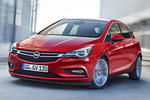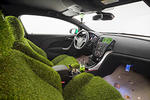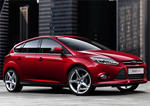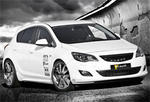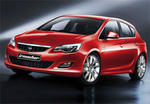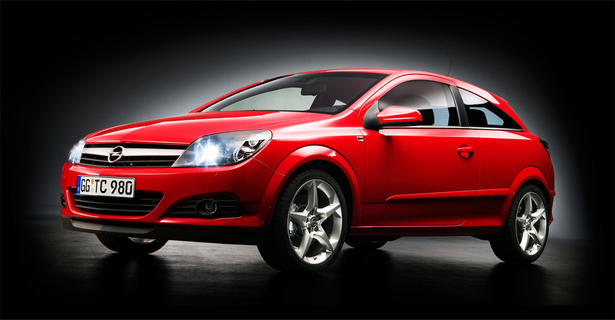
General Motors announced today that the 10 millionth Opel Astra has rolled off the production line in Bochum, Germany. The 10 millionth Opel Astra is a Silver Lightning Astra Station Wagon 1.7 CDTI that was equipped with special features to celebrate this production milestone.
The production of the Opel Astra began on August 12, 1991, with the first model being a magma-red station wagon. The Astra name was adopted from the sister model from the UK. In Britain the Kadett name was swapped for Astra in 1980.
With the 10 millionth Opel Astra produced, this model is the best seller almost 80 countries.
Opel Press Release:
The 10 millionth Opel Astra rolled off the assembly line today in Bochum, Germany – a Silver Lightning Astra Station Wagon 1.7 CDTI equipped with special features to celebrate this extraordinary production milestone.
With more than 500,000 models sold last year in Europe alone, Astra is the absolute best-selling
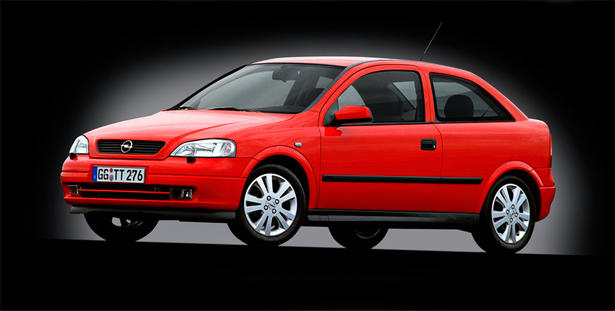
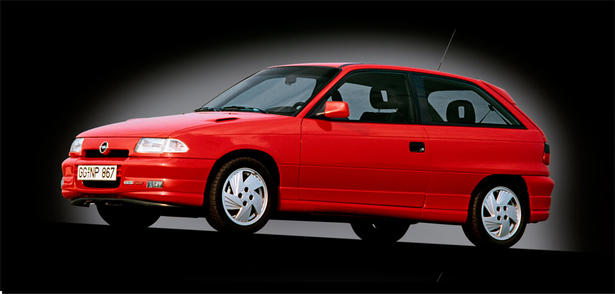
car in the Opel palette and follows in the footsteps of Opel’s Kadett and the brand’s tradition of building quality compact cars.
“The Astra is synonymous with Opel. Its success is also a recognition of our expertise in the compact segment in which Opel has been playing a pioneering role since 1936 and the launch of the first Kadett” says Opel Managing Director Hans H. Demant. “The Astra symbolizes our brand; offering bold design, versatility and advanced technology that meets customer needs. And it is fun to drive.
Worldwide success story began in 1991
The Astra era began August 12, 1991 when the first model – a magma-red station wagon – left the Bochum plant. Opel adopted the name “Astra” from the car’s sister model in the United Kingdom. Vauxhall had renamed the Kadett to Astra in 1980 when the fourth-generation of the compact class car was launched. With ten million units produced worldwide, the Astra is a long-established bestseller in almost 80 countries. And, it can proudly display an array of awards.
In 2008, the Astra GTC with its panorama windshield was singled out as a stylish trendsetter when it was named “Most Fashionable Vehicle” among imported cars in China. A design center in Germany awarded its “Red Spot for High Design Quality” to Astra in 1998. And, in 2001, The Swedish ‘Gröna Bilister’ (“Green Drivers”) Association recommended the Astra 1.6 16V as a “Good Environmental Choice” based on its low emissions.
In addition, three Astra model lines hold a host of sales records. The first generation (1991 - 1998) is still the best-selling Opel model ever: 4.13 million units were produced (excluding Opel Classic), breaking the record of 3.8 million held by the Kadett E (1984 - 1991).
The second Astra generation launched in the spring of 1998 also boasts an impressive production figure of 3.8 million units. That model continues to be built in Gliwice, Poland as the Astra Classic. The third generation was launched in March 2004 and is well on the way to following in its predecessors’ footsteps: Already 1.9 million units have been sold.
The front-wheel drive Astra is produced in eight plants on two continents. In Europe, the current models are built in Bochum, Germany; Antwerp, Belgium; Ellesmere Port, United Kingdom and Gliwice, Poland. As a truly global car, the Astra is also fully or partially assembled in Russia, the Ukraine, Brazil and Serbia. It also is the first compact class model since the Kadett B that is sold in the USA. The Saturn Astra is built in Antwerp, and hit dealerships in the USA and Canada in the closing months of 2007.
The British buy the most Astras. Last year, 119,082 units were sold in the U.K. The second-largest market is Germany (74,226), followed by Italy (43,128) and Spain (41,282). The most popular Astra in Western Europe is the 1.6 ECOTEC model Enjoy.
In Germany, the Astra station wagon held the top spot in 2007, selling better than any other compact wagon.
Today’s Astra: Pioneering technological innovation in the compact class
The Astra continues Opel’s tradition of providing quality compact cars at an affordable price. It is a rite that began with the Doctor’s Car in the 1930s and really took off with the mythic Kadett in the 1960s.
Today’s Astra is distinguished by its progressive design and high driving dynamics at an affordable price. It offers innovative technical solutions that are not givens in this class of car. Included in these technical highlights are the Adaptive Forward Lighting (AFL) headlamp system with dynamic curve light, an advancement in which Opel was a segment leader, and the adaptive IDSPlus chassis system with electronic Continuous Dampening Control (CDC) – usually only found in luxury class and exclusive sports cars. The Astra also provides passengers with plenty of storage space.
A further plus point of the Astra family is its wide and varied model range, more diverse than almost any other model line. This enables customers to configure their car exactly the way they want, meeting all their needs.
Options are extensive, and depending on the country can include:
Seven models -- five-door fastback, three-door GTC, notchback sedan, station wagon, TwinTop, OPC and the AstraVan delivery van. In addition, the Astra G-based “Classic” notchback sedan is sold in certain markets.
Twelve engines -- from economical 1.3 CDTI ecoFLEX turbo-diesel direct-injection unit with an MVEG combined consumption of 5.1 liters per 100 km to 177 kW/240 hp turbocharged gasoline engine, which takes the OPC variant which is capable of reaching 100 km/h in 6.4 seconds.
Six transmissions -- five and six-speed manual, five and six-speed Easytronic, four and six-speed automatic transmissions
Six equipment lines -- including the new INNOVATION version, which features technology components such as AFL bi-xenon curve light as standard
Customers can further individualize their Astra with a choice of 90 options, a selection of packages and original Opel accessories. Altogether, these offer customers almost limitless possibilities to create their “dream car”.
Spotlight
Short Astra-logy
The Astra family keeps on growing. Never before has there been so much variety: With the addition of the new notchback model in fall 2007, there are now seven models from which to choose. This includes the five-door fastback, spacious station wagon, dynamic three-door GTC, sporty OPC, TwinTop for open-air driving fun, the AstraVan (available in selected markets) and the Astra G-based Astra Classic:
Astra Five-Door: Brings high-technology and dynamic driving to compact class
With its dynamic look, the five-door Astra sets itself apart from the competition. Well-balanced proportions are the basis for its harmonious body line. Measuring 4.25 meters long, 1.80 meters wide and 1.46 meters high with a 2.61-meter wheelbase, the five-door model has attractive roominess and comfortable seating. The Astra’s interior boasts surfaces with a high-quality look and feel. The top Cosmo features décor trim and inlays made from luxurious piano lacquer. The Astra also has plenty of room for luggage: it offers a best-in-class storage compartment volume of up to 380 liters (VDA standard), which expands to a maximum of 1295 liters when the rear seats are folded down. With innovative high-technology features like IDSPlus Chassis system and AFL lighting, the Astra offers equipment usually seen only in exotic performance cars.
Astra Station Wagon: Attractive model with ample legroom and luggage space
This Astra model continues Opel’s compact station wagon success story with its elegant design, high driving dynamics and plenty of space for passengers and luggage. This success is highlighted by the customer demand for the Astra station wagon and the numerous comparison tests it has won in specialist automotive publications. Thanks to its 2,703 mm wheelbase (versus 2,614 mm for the five-door), the Astra station wagon offers above-average rear legroom and load volume of up to 1590 liters - a top value in this class. Features such as the FlexOrganizer system for the load area create high interior flexibility.
Astra GTC: Eye-catching fastback model with unique panorama windshield
The Astra GTC (Gran Turismo Compact) entered the market in March 2005, and was singled out by the specialist automotive press as “perhaps the most exciting Opel Astra ever” It is the most popular compact three-door in Europe. It boasts sporty proportions, a slim line, elongated silhouette, arched sloping roof and pronounced front and rear tapering. The expressively-styled body is newly designed – only the hood and front fenders were taken over from the five-door Astra. The successful model’s exclusivity is underlined by a world first: A panorama windshield that stretches back to the B-pillars, creating a unique scope of visibility. It comes as standard with the Astra GTC Cosmo.
Astra OPC: Sports car in compact-class format
With the Astra OPC (Opel Performance Center), Opel advances far into the territory of established sports cars. The coupé-like three-door model is powered by a 177 kW/240 hp, 2.0-liter turbocharged gasoline engine that accelerates from zero to 100 km/h in 6.4 seconds, and has a top speed of 244 km/h. The Astra OPC requires 9.2 liters of fuel per 100 kilometers. Power is transferred to the front wheels via a sporty six-speed manual transmission. In a special 300 horsepower version of this Astra, eight candidates of Opel’s OPC Race Camp will participate later this year in the 24-hour event on the Nürburgring.
The Astra OPC’s striking looks clearly identify it as the top model in its line. The body design with the low front and tailgate spoiler, trapezoidal central tailpipe and large 18-inch wheels in characteristic OPC six-spoke design (tires 225/40) showcases the car’s dynamic potential. In the interior, Recaro sport seats, an instrument panel in OPC design and aluminum pedals all contribute to the high-class, sporty ambience. The latest version is the limited white Nürburgring edition, with a highly-developed chassis, 19-inch wheels and many exclusive design elements.
Astra TwinTop: Elegant four-seat cabrio-coupé
The sporty-elegant Astra TwinTop joined the Astra family in May 2006. Thanks to its innovative three-part retractable steel roof, it transforms a coupé into a convertible in less than 30 seconds at the touch of a button. The four-seater also boasts ample luggage compartment capacity and an innovative “Easy Load” system which allows for easier storage at the press of a button.
AstraVan: Fun-to-drive delivery van with large cargo compartment
Primarily offered in the U. K., the AstraVan’s most distinctive features include robust panel inserts instead of rear side windows and an optional non-glazed tailgate. This model is based on the station wagon and combines the style and comfort of a passenger car with greater utility. The rear axle was redesigned so that the fuel tank could be moved to create an especially large and flat load floor. The torsion-beam rear axle was also modified for heavier loads.
Astra Notchback: Sophisticated family car with classic look
Opel continues a tradition with the Astra notchback as a sophisticated family car. The Astra notchback is produced in Gliwice, Poland, an ideal location to serve the car’s primary markets of Central and Eastern Europe. The predecessor notchback model, Astra Classic, also will continue to be built there.
The new four-door boasts the Astra’s progressive, proportionally-balanced design, dynamic lines and characteristic driving dynamics, together with strong safety features. The new model’s designers adopted the long wheelbase from the station wagon (2703 mm) for generous space in the rear and a large luggage compartment.
Spotlight
Opel Astra History: Road to Success
From 1991 to today: Overview of most important milestones
New bodies, advanced technological features, more extensive equipment and a fresher look – the Opel Astra has undergone major changes in the past 17 years. The following is a summary of the key events in the compact model’s success story:
1991
August 12: Astra F goes into production in Bochum, where the first Kadett was built in 1962
September: Start of sales; three body versions (three and five-door fastback and station wagon) and seven engines (42 kW/57 hp to 110 kW/150 hp) are available
1992
April: Start of notchback sales
1993
March: Premiere of Astra Cabrio at Geneva Motor Show
1993 – 1997: Large-scale electric car testing on the German island of Rügen; ten Astra Impuls 3 test vehicles jointly cover more than 350,000 kilometers
1993 – 2000: Astra station wagon is most popular of all station wagon classes throughout Europe
1994
May: Full-size driver’s airbag becomes standard equipment
September: Model year 1995 enhancements include full-size passenger-side airbag and power steering as standard, modified front-end with new radiator grille, white turn indicators and dark-glass rear lights
1996
March: Astra Cool is first compact car with air conditioning as a standard feature
July: Low-volume production run of Astra CNG station wagons goes on sale: 500 natural gas-powered vehicles are produced for utility companies, public authorities and major customers
October: Model year 1997 enhancements include ABS as standard in all versions; Astra Cabrio is available from the factory with power roof
1997
April: Start of two-year field testing with ten Astra Impuls 3 electric vehicles; practical testing takes place in border region between Belgium, the Netherlands and Germany
September: World premiere of new Astra at the IAA in Frankfurt
October: Astra-based rallye car is produced in accordance with FIA kit car rules
1998
January 5: Astra G production starts in Bochum
March: Sales of new model generation start; three body types (three and five-door fastback and station wagon) and seven engines (48 kW/65 hp to 100 kW/136 hp) are available
April: World premiere of notchback at AMI Leipzig motor show
June: The North-Rhine Westphalia Design Center awards its “Red Spot for High Design Quality” to Astra
November: Premiere of 160 hp Astra OPC at Essen Motor Show; introduction of active head restraints
1999
September: Premiere of Astra Eco 4 – the first family-sized car with consumption of just four liters per 100 kilometers – and Opel Coupé at IAA in Frankfurt
November: Presentation of Astra DTC competition car for the German Touring Car Challenge series (approx. 149 kW/202 hp) and the Astra kit car (approx. 206 kW/280 hp)
December: Astra is top-selling car across Europe with around 745,000 new registrations
2000
February: Roll-out of Astra V8 Coupé for the German Touring Car Masters with a 4.0-liter V8 engine and approx. 338 kW/460 hp
March: Sales of Astra Coupé start
June: 43 automotive journalists from Germany and Austria drive the Astra 1.7 DTI 16V in the 16th Mobil Fuel-Economy Run and achieve an average fuel consumption of just 3.1 liters per 100 kilometers
August: Sales of Astra Eco 4 start; ‘Tour Against the Clock’, world’s largest
fuel-saving test, also begins with some 7000 Opel customers
October: Model year 2001 enhancements include more powerful gasoline engines and doubling of service intervals to 30,000 km/one year
November: Launch of Opel Coupé Turbo with 2.0-liter engine and 140 kW/190 hp;
2001
March: World premiere of Astra Cabrio and Astra Coupé OPC X-Treme at the Geneva Motor Show
July: The Swedish ‘Gröna Bilister’ (“Green Drivers”) association awards Astra
1.6 16V the title ‘Good Environmental Choice’ due to its low emissions
August 12: Tenth anniversary of Astra production
November: Three-door and station wagon versions of Astra OPC with 2.0 ECOTEC Turbo 147 kW/200 hp
2003
September: World premiere of third-generation Astra at IAA in Frankfurt
2004
January: Start of series production in Antwerp/Belgium
March: Sales start in Germany of first compact with AFL lighting
Summer: Expansion of engine range with two 1.9 CDTI ECOTEC common-rail
turbo-diesels (88kW/120 hp and 110 kW/150 hp) and one 2.0 turbo ECOTEC unit with 147 kW/200 hp
2005
Spring: New entry-level 1.3 CDTI ECOTEC diesel engine with 66 kW/90 hp
August: Introduction of 1.9 CDTI ECOTEC with 74 kW/100 hp; maintenance-free diesel particulate filter as standard for all 1.9-liter CDTI engines
October: Record lap for the Astra OPC on the Nürburgring: Manuel Reuter needs only 8:35 seconds to complete the 20.8 km “Nordschleife”
November: 1.8 ECOTEC with 103 kW/140 hp; maintenance-free diesel particulate filter as standard for 1.3 CDTI ECOTEC with 66 kW/90 hp
2006
Fall: Six-speed Easytronic for 1.3 CDTI; 1.8 ECOTEC with four-speed automatic transmission
November: World premiere of Astra notchback at Istanbul Motor Show
2007
February: Enhanced new edition; new 1.6-liter gasoline (85 kW/115 hp) and 1.7-liter CDTI engines with 81 kW/110 hp and 92 kW/125 hp
April: Start of the OPC Race Camp. Candidates train in an Astra OPC for this televised motor sport event
August 23: Production start of notchback variant in Gliwice/Poland
September: Premiere of Astra 1.3 CDTI ecoFLEX at IAA
December: Premiere of the 300 hp-Race Car version for the OPC Race Camp
2008
January: Start of Astra OPC special “Nürburgring Edition” model in a limited production run of 835 units in honor of Manuel Reuter’s Nordschleife record.
Spring: Introduction of INNOVATION equipment version, which includes AFL lighting.
April: Production of ten-millionth Astra in Bochum




